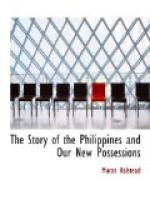CHAPTER XIII
The White Uniforms of Our Heroes in the Tropics.
The Mother Hubbard Street Fashion in Honolulu, and That of Riding Astride—Spoiling Summer Clothes in Manila Mud—The White Raiment of High Officers—Drawing the Line on Nightshirts—Ashamed of Big Toes—Dewey and Merritt as Figures of Show—The Boys in White.
Recent experiences of the United States excite attention to the fashions of the tropics. In Florida our soldiers who invaded Cuba were in a degree and sense acclimated for the temperature of the island that has been for so long “so near, and yet so far,” so wet and yet so hot. But the troops of the Philippine expedition were not prepared by the chilly blasts from the mountains of California for the exceedingly soft airs of Hawaii, though Honolulu was a pleasant introductory school to Manila. Our new possession two thousand miles from the continent, has been preparing for the destiny realized for two generations, and the American ladies who dwell in the islands of perpetual summer in the Pacific, have not submitted wholly to the dominion of the climate and composed themselves to languish in loose and gauzy garments when on the streets. But the Honolulu women, in general, who largely are in the possession of luxuriant proportions, are enveloped in the blandishments of Mother Hubbards, and do not even tie strings about themselves to show where they would have spectators to infer their waists ought to be. They go about flowing and fluttering in freedom, and have all the advantages due the total abandonment of corsets, and suffer none of the horrors of tight lacing recorded in medical publications. The Mother Hubbard gown is not without its attractions, but we can hardly say they are too obvious, and slender figures are lost in voluminous folds that are billowy in the various ways and means of embracing the evolutions of beauty. And the native singers seem fully justified in throwing the full force of their lungs and the rapture of their souls into the favorite chorus, “The Honolulu Girls Are Good Enough for Me.” The refrains of the Hawaiian songs are full of a flavor of pathos, and there is the cry of sorrows, that seem to be in the very air, but belong to other ages. The Honolulu females of all races have flung away side saddles with their corsets, and bestride horses and mules with the confidence in the rectitude of their intentions that so besets and befits the riders of bicycles. People would stare with disapproval in Honolulu to see a woman riding with both legs on the same side of a horse, and those wandering abroad in the voluminous folds of two spacious garments disapprove the unusual and unseemly spectacle.




